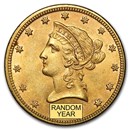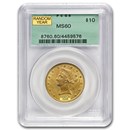$10 Liberty Eagle Coins (1795-1907)
Top Pick

$10 Liberty Gold Eagle (Cleaned)
$1,411.82
| Quantity | Check/Wire |
|---|---|
| 1 - 9 | $1,421.82 |
| 10 - 24 | $1,416.82 |
| 25 + | $1,411.82 |
Top Pick

$10 Liberty Gold Eagle XF (Random Year)
$1,441.82
| Quantity | Check/Wire |
|---|---|
| 1 - 9 | $1,451.82 |
| 10 - 24 | $1,446.82 |
| 25 + | $1,441.82 |
Top Pick

$10 Liberty Gold Eagle BU (Random Year)
$1,481.83
| Quantity | Check/Wire |
|---|---|
| 1 - 9 | $1,491.83 |
| 10 - 24 | $1,486.83 |
| 25 + | $1,481.83 |

1803 $10 Turban Head Gold Eagle MS-63 NGC (Large Stars Reverse)
$105,495.00

| Grade | Mintage | Population |
|---|---|---|
| 15,017 | 0 |

1839 $10 Liberty Gold Eagle Head of 1838 AU-53 NGC (Lg Letters)
$7,669.00

| Grade | Mintage | Population |
|---|---|---|
| 25,801 | 28 |
About The $10 Liberty Eagle Coins
The $10 Liberty Eagle Coins were a type of gold coin that the United States minted from 1838 to 1907.These coins comprised 90% gold and 10% copper and weighed 16.72 grams. They featured a left facing bust of Liberty on the obverse and a heraldic eagle on the reverse, along with the denomination of "Ten D." (which stood for "Ten Dollars").
The $10 Liberty Eagle Coins were minted in various locations throughout the United States, including Philadelphia, New Orleans, San Francisco, and Carson City. The coins minted in Carson City are especially sought after by collectors due to their rarity.
These coins were widely circulated and were used in everyday commerce in the United States. However, they were eventually phased out in 1933 when President Franklin D. Roosevelt issued an executive order prohibiting the hoarding of gold and requiring citizens to turn in their gold coins to the government in exchange for paper currency.
About The Design
The $10 Liberty Eagle Coins design is one of the most iconic and recognizable in American numismatic history. The obverse of the coin features a left facing bust of Lady Liberty, with a coronet inscribed with the word "Liberty" on her head. Her hair is tied back in a bun, surrounded by thirteen stars (representing the original thirteen colonies of the United States). The date of issue is located at the bottom of the design.The reverse features a heraldic eagle with its wings outstretched, perched on an olive branch and a bundle of arrows. A wreath surrounds the eagle, and the words "United States of America" and "Ten D." (for "Ten Dollars") are inscribed at the top and bottom of the design, respectively.
The design of the $10 Liberty Eagle Coins is often praised for its beauty and simplicity. The bust of Lady Liberty is highly detailed and realistic, and the eagle on the reverse is powerful and majestic. The design has stood the test of time and remains a favorite of collectors and investors.
History Of The $10 Liberty Eagle
The $10 Liberty Eagle coin was first introduced in 1838 to replace the earlier $10 Capped Bust design, which had been used since 1804. The Liberty Eagle was designed by Christian Gobrecht, who was then serving as the chief engraver at the United States Mint.The Liberty Eagle was one of the longest-running designs for any U.S. coin, with production continuing until 1907. During this time, the coin saw changes in its design and production. For example, in 1866, the motto "In God We Trust" was added to the coin's reverse above the eagle, while in 1867, the design of the reverse was slightly modified to make the eagle appear more powerful and dominant.
The $10 Liberty Eagle coin was widely used in commerce throughout the United States during the 19th century, particularly during the California Gold Rush of the 1850s. However, as the United States moved away from the gold standard in the early 20th century, demand for gold coins like the Liberty Eagle declined. The Indian Head Eagle eventually replaced the coin in 1907.
For those interested in exploring more of America's famous gold coinage, consider our comprehensive selection of United States Mint Gold Coins. APMEX carries just about everything, from modern Gold Eagles, to historic Pre-1933 gold options.
Check out what other customers are saying.













